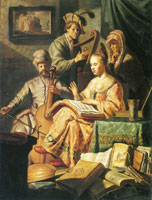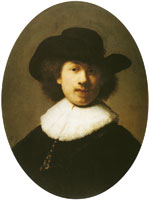
Rembrandt
Ecce Homo
163454.5 x 44.5 cm
Oil on paper on canvas
Signed beneath the clock in the right background: Rembrandt. f/1634
The National Gallery, London
Literature
Catalogues raisonnés
HdG 128
Bredius 546
Bauch 62

Gerson 72
Bredius/Gerson 546

Corpus II A 89
Tümpel 50
Corpus VI 112

Manuth 52
Giltaij 591
Collection catalogues
Neil MacLaren, revised and expanded by Christopher Brown, The Dutch school, 1600-1900, London, 1991, pp. 346-349, plate 290
Christopher Baker and Tom Henry, The National Gallery complete illustrated catalogue, London, 2001, p. 560
David Bomford, Jo Kirby, Ashok Roy, Axel Rüger, Raymond White, Rembrandt, London; [New Haven, Conn.], 2006, nr. 4
Literature
Gary Schwartz, Rembrandt zijn leven, zijn schilderijen, Maarssen, 1984, fig. 104
Ellinoor Bergvelt, Michiel Jonker, Agnes Wiechmann (eds.), Schatten in Delft, Zwolle; Delft, 2002, fig. 67
Ernst van de Wetering, Rembrandt in nieuw licht, Amsterdam, 2009, fig. 104
Ernst van de Wetering, Rembrandt, Amsterdam, 2016], fig. 124 (detail)
Stephanie S. Dickey (ed.), Rembrandt and his circle, Amsterdam, 2017, fig. 15.11, plate 15.11
Exhibitions
2019 Young Rembrandt, Nr. 117
2016 Rembrandt intime, Nr. 27
1991 Rembrandt: the Master & his Workshop, Nr. 15
Provenance
perhaps identical with the `Ecce Homo' in grisaille in the inventory of Rembrandt's goods made in July 1656 in connection with his bankruptcy
possibly in the inventory of Jan van de Cappelle's possessions made between January and August 1680
according to Smith it was sold with another grisaille in the Willem Six sale, Amsterdam, 12 May 1734; the only possible lot in that sale is 175 which consisted of three undescribed grisailles by Rembrandt, bought by de Barij
in the 1738 inventory of Valerius Röver, marked `bijgeleijt 1738', is: 'de capitaalste tekening die van Rembrandt bekent is, verbeeld de groote Ecce Homo, waar na hij de print heeft gesneden — met olieverwe op papier int graauw geschildert', making it unlikely (but not impossible) that it was in the Six sale
purchased by Johan Goll van Franckenstein of Amsterdam
sold by Goll van Franckenstein in 1827 to the Amsterdam dealer, A. Brondgeest
passed from Brondgeest into the possession of Thomas Emmerson, London
collection of Jeremiah Harman by 1836
J. Harman sale, London, 17-18 May 1844, lot 92, bought by John Smith
sold by Smith to G. Blamire
George Blamire sale, London, 7-9 November 1863, lot 57, bought by Mulvaney
Sir Charles Lock Eastlake (d. 1865)
National Gallery, London, bought from the executors of Lady Eastlake, 1894
1




